 david coombe history
david coombe history
SUMMARY: S.T. Gill accompanied John Ainsworth Horrocks' small expedition from July to September 1846. This is the only occasion we observe Gill on a day-to-day basis, thanks to the journal extract published in the newspaper. But we also get an uncommonly good idea of his activity in the next few months in the lead up to the February 1847 Exhibition of Pictures. This article focusses on the period from Gill's return and the series of 33 watercolours Gill hung in the exhibition. This article tries to identify the 33. The article is complemented by an interactive map placing the works on the expedition route.
Article type: NARRATIVE, ANALYSIS, CATALOGUE & MAP
In this article ...
John Ainsworth Horrocks (1818 – 1846) led a small expedition in 1846 intending to push European exploration to the northwest of the head of Spencer's Gulf. S.T. Gill was one of the expeditioners, as accompanying artist.
Horrocks kept a journal from when his party started from Penwortham village on 29 July and up to 27 August 1846. (It was not published until 1906 – see References.) He was fatally wounded on 1 September in a firearms handling accident.
A section of Gill's journal – 8 August to 24 September – was published as Progress Of Discovery – Expedition To The North-West in the South Australian Gazette and Colonial Register on 10 October 1846. The reader may wish to read Gill's account.
The focus of this article is not the expedition itself, but Gill's watercolours from it. The article is complemented by an interactive map.
The map shows the approximate route of the Horrocks expedition, includes extracts from Horrocks' and Gill's journals and locates Gill's main pictures. The map opens in another window and the reader may wish to have this at hand to refer to.
Horrocks died on Wednesday 23 September, his funeral was the following day, and Gill would have returned to Adelaide soon after.
DEATH OF MR HORROCKS. – We deeply regret to announce the death of Mr John Horrocks on Wednesday week last, from the effects of the wounds he had received, and the exhaustion consequent upon his long journey from Mount Arden to his late residence at Penwortham. We are promised, in time for next week, by Mr Gill, the artist, full details of the expedition, which will, no doubt, be read with interest. Mr Gill is at present in the country, completing the sketches made during the expedition – with the view, we hope, of submitting them to the public when finished.1
One wonders where Gill made his country stay and if it may have been at his father's section on the Upper Sturt.
Gill kept his promise to the newspaper and a portion of his diary, from 8 August to 24 September, was published the following week under the heading Progress of Discovery – Expedition to the North-West.
A month later Gill was spotted in town and had new rooms in Leigh Street. On 7 November his student W.A. Cawthorne wrote:
I have seen Gill for the first time since his arrival from the expedition. With his 25 pictures of the same dreary country. He has set up again close by as Artist Laureate. There is going to be an "Amateur Artist Exhibition". I am going to paint for it.2
It would be a month before Gill was ready to present his completed watercolours. But during this time Cawthorne made his own versions of at least three Horrocks scenes. (Analysis below shows this was before Gill had reached his own final designs.)
In another month, on 12 December, it was reported Gill's "collection of sketches" was destined for a private raffle among Horrocks' friends.3 Unfortunately the same day it was also reported that the list of ticket holders had been lost!
LOST – On Thursday or yesterday, the Subscription List to Mr Gill's drawings of scenes in the interior, taken during Mr Horrocks's journey. The finder is requested to forward it to Capt. Sturt, at the Public Offices.4
Come the new year and Gill's collection, now numbering 33 pictures, was ready for the raffle.
THE ARTS IN SOUTH AUSTRALIA. – Mr Gill has politely favored us with an inspection of his series of views, depicting the most remarkable scenes met with by the expedition under the conduct of the late Mr Horrocks. The series comprises no less than thirty-three views, the execution of which, as faithful transcripts of nature and in some instances of a territory untrodden by white men, reflects much credit on the talented artist. Some of these pictures are possessed of a peculiar interest, as, for instance, one representing the extreme point attained by the party. In the foreground appears the invalid's tent, with Mr Gill watching outside – the country in the background presenting a most inhospitable and desolate appearance. Another represents Mr Horrocks returning, after having sustained that distressing accident which hurried him to a premature grave; while a third exhibits his funeral. There is also a very graphic representation of a fight with the blacks, and of a previous interview with a sable pair, whose expression of countenance is absolutely satanic. This interesting series of pictures is to be raffled for in the course of a few days.5
[The "satanic" facial expression on two Aboriginal men attributed by the South Australian newspaper is not consistent with the image we see, nor is any sense of evil represented in the diaries of Horrocks or Gill.]
At the end of the week there was news of the raffle, of Gill's fresh artistic endeavour and an announcement of Adelaide's first exhibition of artists.
A raffle came off on Wednesday at the Government Offices, thirty members at one guinea each, for the paintings comprising original sketches taken by Mr Gill during his travels and sojourn in the bush with the late lamented Mr Horrocks.
–––
Mr Gill, the artist, who accompanied Mr Horrocks on his ill-fated expedition beyond the northern confines of settled location in this province, with a view to find more country adapted for the depasturing of sheep, &c., in a north-west direction, is now occupied in the production of a bird's-eye view of the Glen Osmond silver lead mines, in which the respective lodes and their appellations will be distinctly indicated. Although short of completion, it is already manifest that the drawing will be a faithful representation; and to parties in England it will vividly depict the far-famed and really beautiful locality.
–––
In addition to the treat which is to be afforded the good people of Adelaide and their country friends at the approaching exhibition, under the auspices of the Agricultural and Horticultural Society, it is intended that an exhibition of oil paintings, water colour, and pencil drawings, by amateurs, shall take place at the Council Chamber during the same week...6
The raffle is somewhat puzzling; did it only raise thirty guineas?
The exhibition organising committee was chaired by Charles Sturt and had Charles Berkeley as secretary. (Martha Berkeley would show 14 works.) Gill initially co-ordinated entries.
THE FINE ARTS IN SOUTH AUSTRALIA. – An exhibition is to be opened during the week of the Agricultural and Horticultural Show for the exhibition of paintings and drawings by our South Australian artists – professional and amateur. His Excellency the Governor has kindly granted the use of the Council Room, and a Committee has been formed to make the preliminary arrangements – of which official notice will be given in our next. In the meantime, Mr Gill, the artist, will receive at his rooms in Leigh street, such paintings as are desired to be exhibited; and we mention this circumstance at once, under the impression that an early transmission of finished paintings will greatly facilitate the labors of the Committee.7
An Exhibition of Pictures, principally the work of Colonial Artists ran over a week from Thursday 11 February8 and showed 178 pictures.9 Gill was the most prolific exhibitor with 62 entries, including his 33 work Horrocks series. He also showed five other Horrocks related pictures separate to the series. Judging by the financial summary10 (and conservatively assuming about a quarter bought catalogues) about 400 attended over 6 open days.
For the 33 work Horrocks series exhibited, see following for a summary: The Series of 33 Exhibited | Analysis and below for an analysed list: Appendix: Gill's Exhibited 33 + 5 Horrocks Works | Analysis.
For more on the other exhibited Gill works, see: February 1847 Exhibition of Pictures.
Gill's 33 numbered 90 to 122 in the exhibition catalogue and were hung almost in chronological order.11 The order compares well with Gill's and Horrocks' expedition diaries.
In this article I try to identify these original 33. There is a good but imperfect correspondence with known watercolours in the Art Gallery of South Australia (AGSA), National Library of Australia (NLA) and State Library of Victoria (SLV). It seems not all 33 pictures have survived, an obvious example being "122. Funeral of Mr. Horrocks". The State Library of New South Wales (SLNSW) holds important early copies of three of the 33 by Gill's student W.A. Cawthorne.
If you'd prefer to skip this analytical detail and resume the narrative just scroll down or jump to Gill Refines His Images | Narrative & Analysis.
The challenge of identifying the original series of 33 is all the greater because of Gill frequently revisited the Horrocks expedition as a subject. Later works include S.T. Gill's Set of South Australian Scenes – Mr Bishop, 1849 and a set for Arthur Horrocks.
NLA's R347 to R354 are, I conclude, from the Horrocks 33, see: Sturt's 13 Watercolours presented by Queen Elizabeth II, 1956. These watercolours are all about 18.5cm x 31.5cm. AGSA 997P34 to 997P40 are also likely from the Horrocks 33, with five having the same dimensions and two others being about 43cm x 58cm. I add a further three AGSA watercolours and one from SLV. About 20 known watercolours correspond well with the 33.
Following the expedition, the first to report seeing Gill's works was his student W.A. Cawthorne; he noted Gill's "25 pictures of the same dreary country". (Gill had just moved into his new rooms in Leigh Street.) Probably before Gill could turn 25 into 33, Cawthorne sketched his own versions of at least three Horrocks scenes: Crossing the Neck of the Lake Torrens (SLNSW PX*D 30 f.04), View of the N.W. from Flinders Range (SLNSW PX*D 30 f.26a) and Attack of the Natives (SLNSW PX*D 30 f.26b). (The last, a pencil sketch, could be by Gill himself.) The first two are slightly different to Gill's final watercolour versions, so either Cawthorne took some licence or Gill later refined the scenes Cawthorne saw.
The latter conclusion seems most likely and can be deduced by comparing three versions of the scene in which Horrocks and Gill stand on the top of Point Encounter (Uro Bluff) with a view to the northwest.
In Gill's watercolour (left) in his final 33, Country NW of tableland, Aug. 22 (NLA R347) we see Horrocks and Gill standing together examining Gill's sketchbook.
However in Cawthorne's version View of the N.W. from Flinders Range (SLNSW PX*D 30 f.26a – not digitised and not shown), Gill reclines (probably sketching) and Horrocks stands with a gun.
A similar arrangement to Cawthorne's is Gill's 1849 version (right) 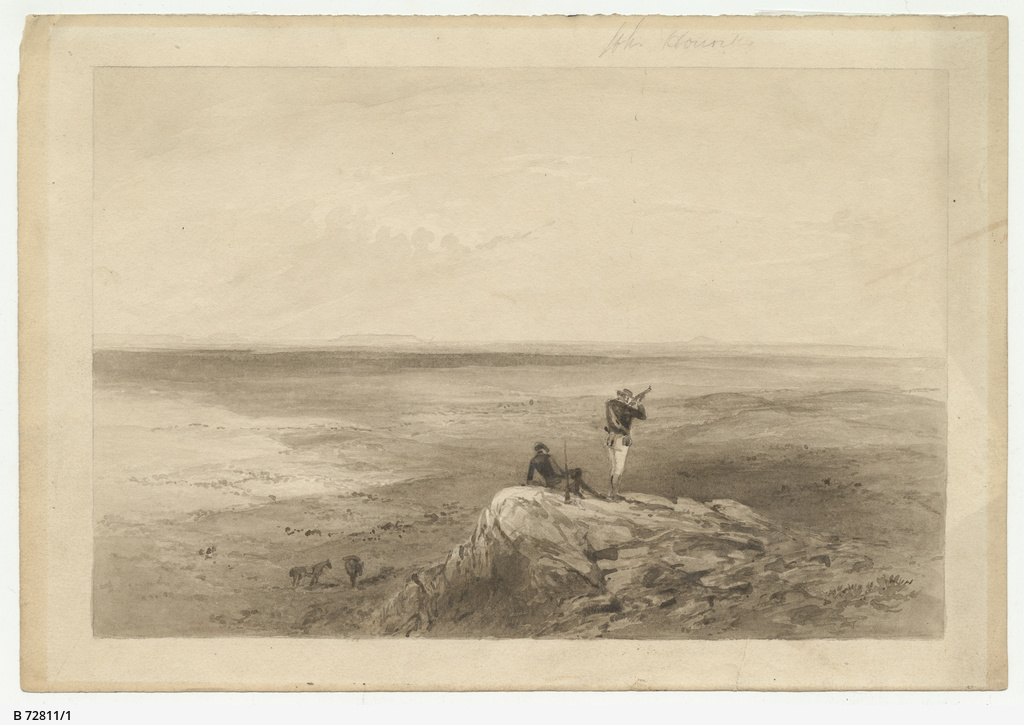 Country N.W. of Point Encounter (SLSA B 72811) in which Gill (left) reclines with gun and Horrocks (right) takes a sight.
Country N.W. of Point Encounter (SLSA B 72811) in which Gill (left) reclines with gun and Horrocks (right) takes a sight.
The most straightforward explanation is Gill's original sketch had himself reclining at left and Horrocks standing at right; this was the scene Cawthorne replicated and was also one Gill himself later used in 1849. But this member of the 33 series is a grander, more heroic, imagining.
More significant than this subtle rearrangement, is the discrepancy in the pair's journal entries for that day. Gill says they both ascended the hill; Horrocks says he alone went up.12 Just before reaching the base of the hill, Horrocks and Gill had had a difficult encounter with Aboriginal people. In that context it would have been prudent for Horrocks to climb the hill to take a sight and leave an armed Gill minding the horses. Gill emphasised his point by picturing (left) the unminded horses at the bottom in 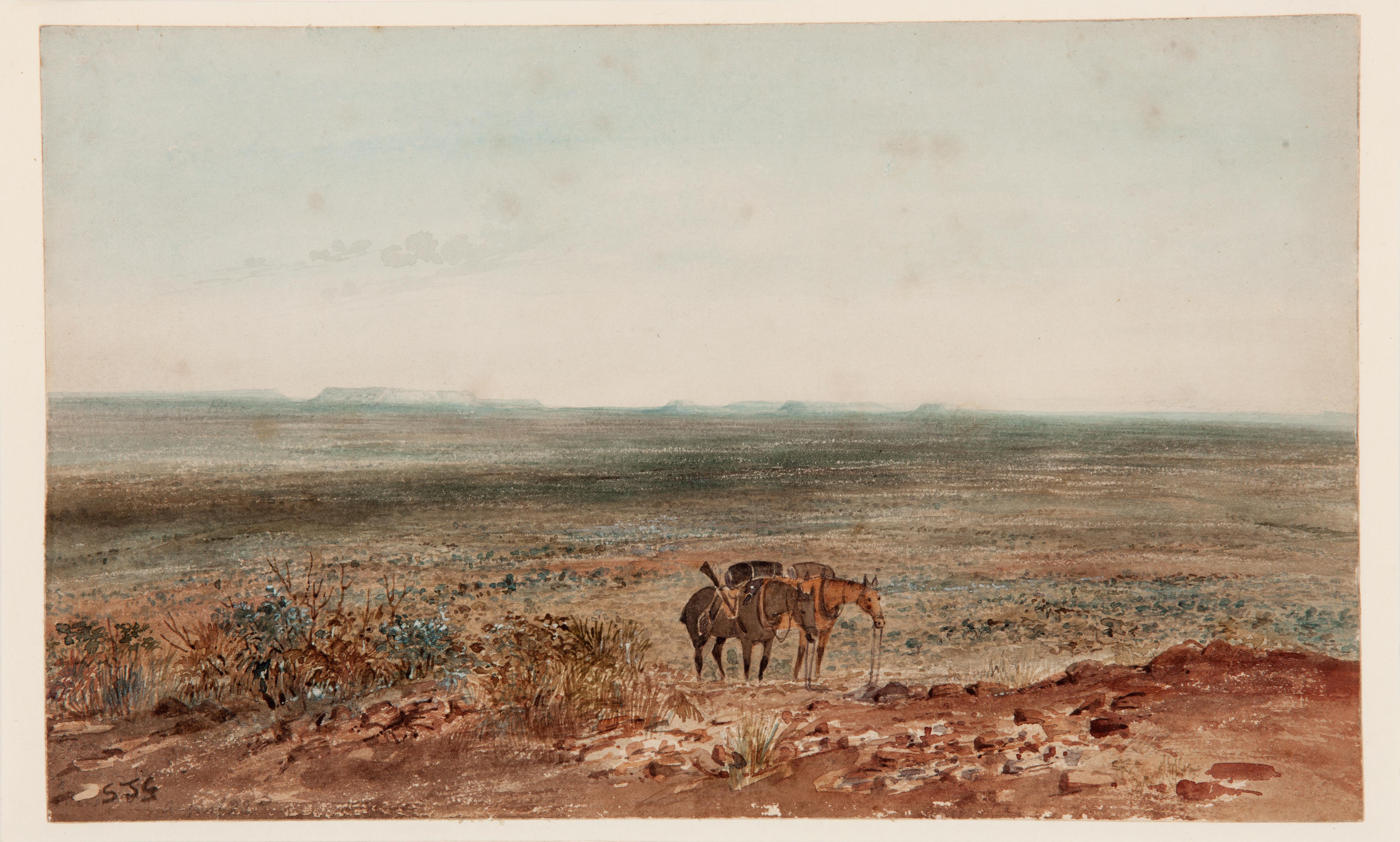 Looking SW from Table Land, August 22nd (AGSA 997P39).
Looking SW from Table Land, August 22nd (AGSA 997P39).
Both journal entries are unambiguous. The discrepancy seems more than inadvertent error. Gill's journal was published in the newspaper at the time, but Horrocks' journal wasn't published until 1906 by the Geographical Society (RGSA:SA 1906). Gill's seems to have adjusted the narrative to underpin his paintings. Gill reinforced his artistic narrative not just by the image of the pair at the top of Point Encounter, but also by the image of the unminded horses at the bottom.
Overall the journal evidence is challenging:
I've amassed evidence in an attempt to build a place and time machine. Despite the volume, data is imprecise and missing. It's a capsule you can't exit and has the finest of cracks to peer out from. However, we see some things.
The analysis of time and place, of topography, of satellite imagery – leveraged by the interactive map – helps restore Gill's series of 33 to its original arrangement. (I don't expect my map placements to be the final word.)
We see Gill likely adjusted his journal to suit his images. With his various versions of Point Encounter, we see Gill a little less as a documentary maker and a little more as a creative. And we have more insight into the development of his works between October and December 1846.
For most of the expedition Gill's order of sketching matched the progress of the expedition. This changed with the extended time at Depot Creek and we see that at the Exhibition of Pictures Gill varied the sequence for a clearer narrative.
As to the pictures themselves, I note in the series of 33 that we never see the face of the late John Horrocks. (Curiously, we see Kilroy's face only once.)
In the end Gill's journey with Horrocks was not so much as the expedition's accurate draftsman but more as its public storyteller. It appears he strayed from his intention at his pre-expedition supper of "a full, true, and accurate report of his adventures".13
By the way, what happended to Harry the camel? Harry was shot after the expedition. It was reported in 1880 that John Horrocks' brother Arthur had shot the camel. However in the 1920s the prevalent story became that E.B. Gleeson did so in response to John Horrocks' deathbed request and yet his unsteady hand meant another had to finish the job. [I previously documented these reports and the late development of the "Camel Shoots Man" joke.]14 There's no doubt someone shot Harry. In December 1846 W.A. Cawthorne notes in his diary, "His camel at his death was shot." But there is no suggestion of blame or vengeance in Horrocks' letter from Depot Creek, nor in Gill's diary or pictures. I don't think John Horrocks had it in for Harry.
To see the works, with accompanying notes, just scroll down or jump to the List of Works.
Cawthorne. William Anderson Cawthorne - journal, 1846-1849. Digitised at SLNSW: <https://collection.sl.nsw.gov.au/record/9gkdb3m9>.
Gill 1846. "Progress Of Discovery. - Expedition To The North-West." South Australian Gazette and Colonial Register, 10 October 1846: 4. <http://nla.gov.au/nla.news-article195934231>
Grandison, Ralph. The relocation of fifteen sites painted by S. T. Gill whilst accompanying the Horrocks' expedition of 1846. Proceedings of the Royal Geographical Society of Australasia. South Australian Branch, v.83, 1983: 12-21.
RGSA:SA 1906. John Ainsworth Horrocks' Journal Proceedings of the Royal Geographical Society of Australasia : South Australian Branch. v.8, 1906: 36-47. Also map Route taken by J.A. Horrocks.
See also: John Ainsworth Horrocks' 1846 Expedition Journal.
You can scroll down to see all pictures along with detailed notes or click a link to jump to a specific work from the list.
Detailed notes each include a link to the map location for the view (where available).
 First camping ground after leaving Campbell's Station, August 9th '46 | Art Gallery of South Australia 997P34
First camping ground after leaving Campbell's Station, August 9th '46 | Art Gallery of South Australia 997P34
Artist: Gill, S.T. | Date: 1846-08~/1847-01~ | Appleyard cat. n/a | 18.9(H) x 31(W) cm
Catalogue: S.T. Gill's Horrocks Expedition Pictures 1846-1847
February 1847 exhibition no. 97 "Camp on Creek N. of Mt. Remarkable".
The view is across a creek to five expeditioners, tents, camel, horse and cart. At left are the expedition goats and in the distance the Flinders Range.
On 7 August, Horrocks wrote "reached Malcolm and Campbell's cattle station, about one and a half miles from the foot of Mount Remarkable" and on 8 August: "Camped on the Third Creek from last night's station." Gill wrote they moved on at about 10 the following morning (9 August).
This may be the same location as James Henderson's sketch from the Frome Expedition Reedy Creek | SLSA B 2434/2.
Catalogue Group: The same dimensions as the Horrocks pictures of Sturt provenance (NLA).
Map | S. T. Gill and Horrocks expedition 1846
552
Looking north from Flinders Range | National Library of Australia R348
Artist: Gill, S.T. | Date: 1846-08/1847-01~ | Appleyard cat. 90 | 18.8(H) x 31.5(W) cm
Catalogue: S.T. Gill's Horrocks Expedition Pictures 1846-1847
February 1847 exhibition no. 98. "Sketch from Stony Point, looking E.S.E."
On 10 August 1846 Gill noted in his diary: "I took two sketches from Stoney Point behind the camp." Gill reclines (centre foreground).
Grandison locates this view at Mount Maria, near Wilmington, looking N.E. to Mookra Tower (Stokes Hill), noting this would make the previous 1956 title "Distant View of Mt Arden" incorrect. Grandison's location is consistent with the scene and reverse inscription.
At left before the distant range appears to be a body of water. There is no permanent water body in this geography, but there may have been surface water at the time or Gill was picturing distant vegetation.
Inscribed oddly on the reverse: "Looking N.E. (April crossed out) Augst 10/ 6 (over) 07 / From F. Range(s)".
Catalogue Group: NLA R347 to R354 are from the Horrocks 33, based on subject matter and Sturt provenance.
Map | S. T. Gill and Horrocks expedition 1846
285
Looking SW to Spencers [i.e. Spencer] Gulf | National Library of Australia R351
Artist: Gill, S.T. | Date: 1846-08/1847-01~ | Appleyard cat. n/a | 18.5(H) x 31.6(W) cm
Catalogue: S.T. Gill's Horrocks Expedition Pictures 1846-1847
February 1847 exhibition no. 99 "Spencer's Gulf, from Flinder's [sic] Range".
A southwest view to Spencers Gulf and beyond. Foreground from left to right: Jimmy Moorhouse and Gill as the artist at work. Inscribed on reverse (likely by Gill): "Spencers Gulf from F. Range / August 10th".
"Thursday, 13th [August]. – I took native Jimmy [Moorhouse] and went out on the hills sketching; found the country exceedingly rough and stoney, as well as steep and difficult to travel over; returned to the camp about 4 o'clock, very tired and foot-sore." (Gill's diary).
There is a readily accessible vantage position with a southwest view that corresponds with this scene apparently looking over Mount Granger on the near shore, across to the far shore with the three hummocks and a tableland at right. Grandison locates the vantage point as Hancocks Lookout.
Title from caption l.l. "Looking SWest to Spencers Gulf [Gulph crossed out]".
Catalogue Group: NLA R347 to R354 are from the Horrocks 33, based on subject matter and Sturt provenance.
Map | S. T. Gill and Horrocks expedition 1846
307
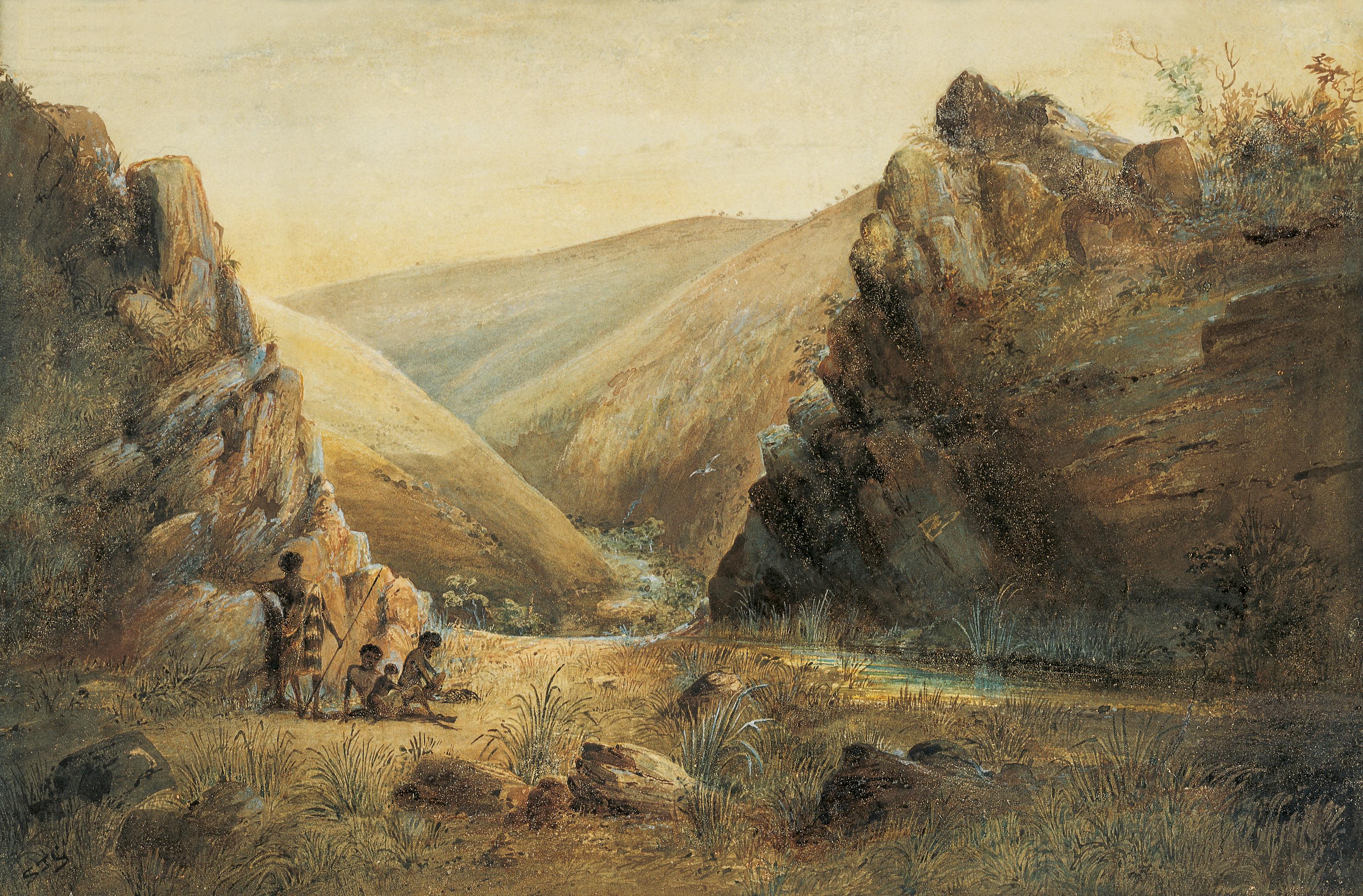 Stony Creek, Mount Remarkable Survey, from above the fall | Art Gallery of South Australia 758HP14
Stony Creek, Mount Remarkable Survey, from above the fall | Art Gallery of South Australia 758HP14
Artist: Gill, S.T. | Date: 1846-08/1847-01~ | Appleyard cat. 89 | 26.3(H) x 39.2(W) cm
Catalogue: S.T. Gill's Horrocks Expedition Pictures 1846-1847
February 1847 exhibition no. 100 "Pass through Flinders Range".
Appleyard (90) notes AGSA's title "Stony Creek, Mount Remarkable Survey, from above the fall" is "from the photograph of another version once in the possession of the Horrocks family in England."
This picture corresponds well with these photos of Horrocks Pass: https://collections.slsa.sa.gov.au/resource/B+17252 and https://collections.slsa.sa.gov.au/resource/PRG+1480/1/338/.
It seems fairly reasonable to equate the two titles.
Catalogue Group: In the Horrocks 33, based on subject matter.
Map | S. T. Gill and Horrocks expedition 1846
284
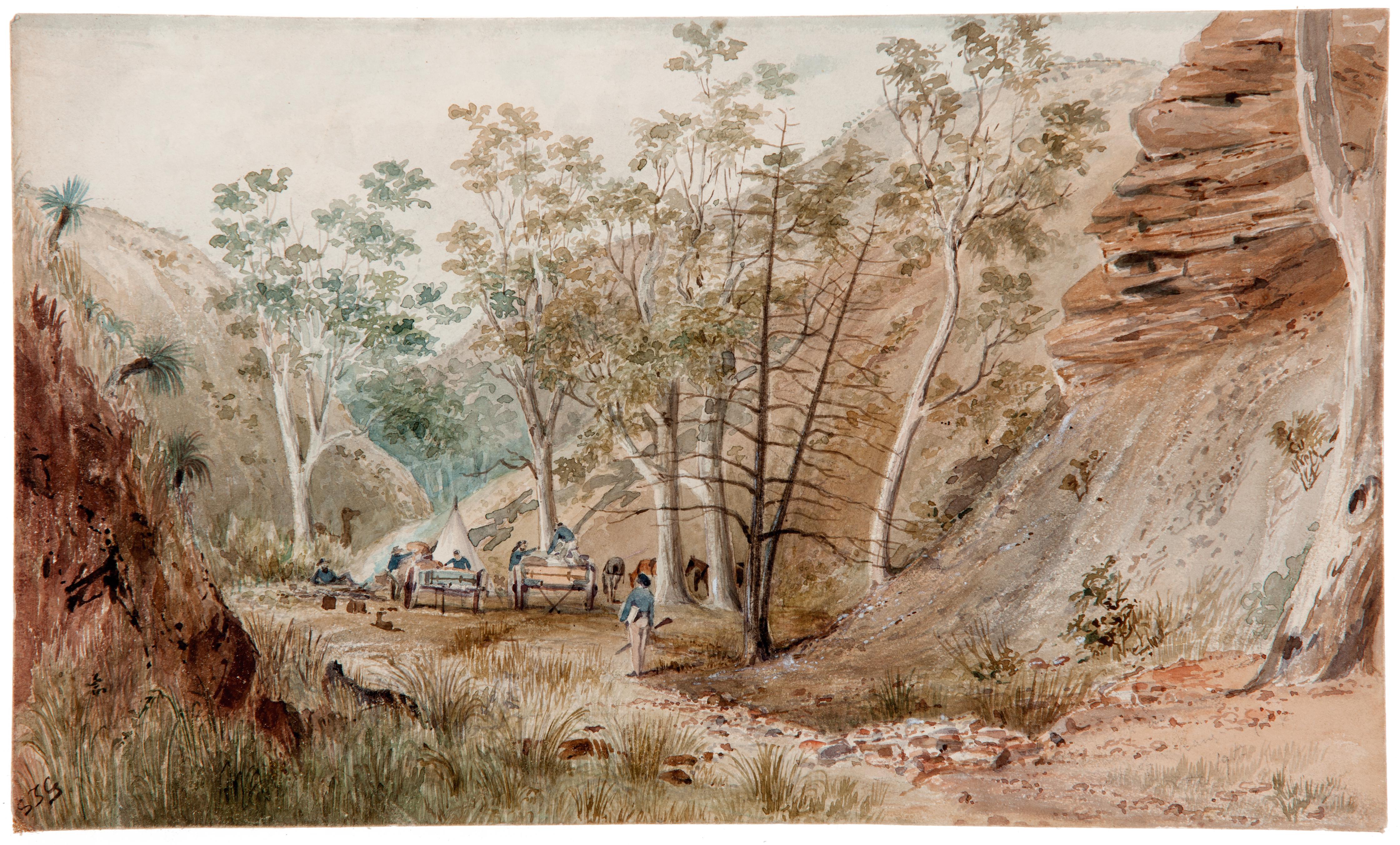 Camp in the bed of creek, Flinders Range | Art Gallery of South Australia 997P35
Camp in the bed of creek, Flinders Range | Art Gallery of South Australia 997P35
Artist: Gill, S.T. | Date: 1846-08/1847-01~ | Appleyard cat. n/a | 43.2(H) x 58.3(W) cm
Catalogue: S.T. Gill's Horrocks Expedition Pictures 1846-1847
February 1847 exhibition no. 101 "Horrock's [sic] camp in bed of creek, Flinder's [sic] Range".
The scene shows the expedition camp in a creek bed with Gill and five other men, Harry the camel, Horrocks' dog, about four horses and two drays. Gill has just returned from sketching. If the 1847 exhibition was in good sequence, then this camp is on the night of 18 August (morning of 19 August) immediately after the range crossing. "Returned for the drays about one and a half mile up the valley, where we camped and got one of them safely down." (Horrocks, 18 August)
Some pencilled artist notes are visible lower right including (possibly) "/9th" or (more likely) "19th". This would suggest this image is intended to be the camp on 19 August on the western side of Horrocks Pass.
Less likely is that, with the five other men all seeming European, then they are Horrocks, Theakston, Kilroy, Garlick and Campbell, with Aboriginal man Moorhouse omitted. Campbell was only with the party from 8 to 11 August, suggesting this could be the morning of the 9th, 10th or 11th. The party remained on the eastern side from the 11th after breaking an axle until the 17th when they began crossing the range.
The trees appear to be Callitris glaucophylla (white cypress pine) which is commonly used by Gill in portraying the Horrocks expedition.
Catalogue Group: In AGSA 997P34 to 997P40 the majority of which are the same dimensions as the Horrocks pictures of Sturt provenance (NLA).
Map | S. T. Gill and Horrocks expedition 1846
304
Mt. Brown from Camp looking NNE, Augst. 20th | National Library of Australia R354
Artist: Gill, S.T. | Date: 1846-08/1847-01~ | Appleyard cat. 91 | 18(H) x 31.2(W) cm
Catalogue: S.T. Gill's Horrocks Expedition Pictures 1846-1847
February 1847 exhibition no. 102 "Mt. Brown, from camp W. side of Flinder's [sic] Range".
The scene shows the expedition camp on a plain with Mount Brown and Flinders Range in the background. There appear to be six men in camp: two at a tent (back left) and four near the camp fire. At the fire (left to right) are likely: Horrocks, Theakston sitting on a box, Gill on ground sketching and Kilroy standing. The two other men (at the tent, left) are likely Garlick (cook and tent-keeper) and Moorhouse. There are two drays and three horses. The camel is not seen. Dated 20 August on the reverse, this seems to be the morning of that day. "We camped in a patch of wild oats three miles from the creek." (Horrocks, 19 August)
The trees appear to be Callitris glaucophylla (white cypress pine) which is commonly used by Gill in portraying the Horrocks expedition.
Catalogue Group: NLA R347 to R354 are from the Horrocks 33, based on subject matter and Sturt provenance.
Map | S. T. Gill and Horrocks expedition 1846
286
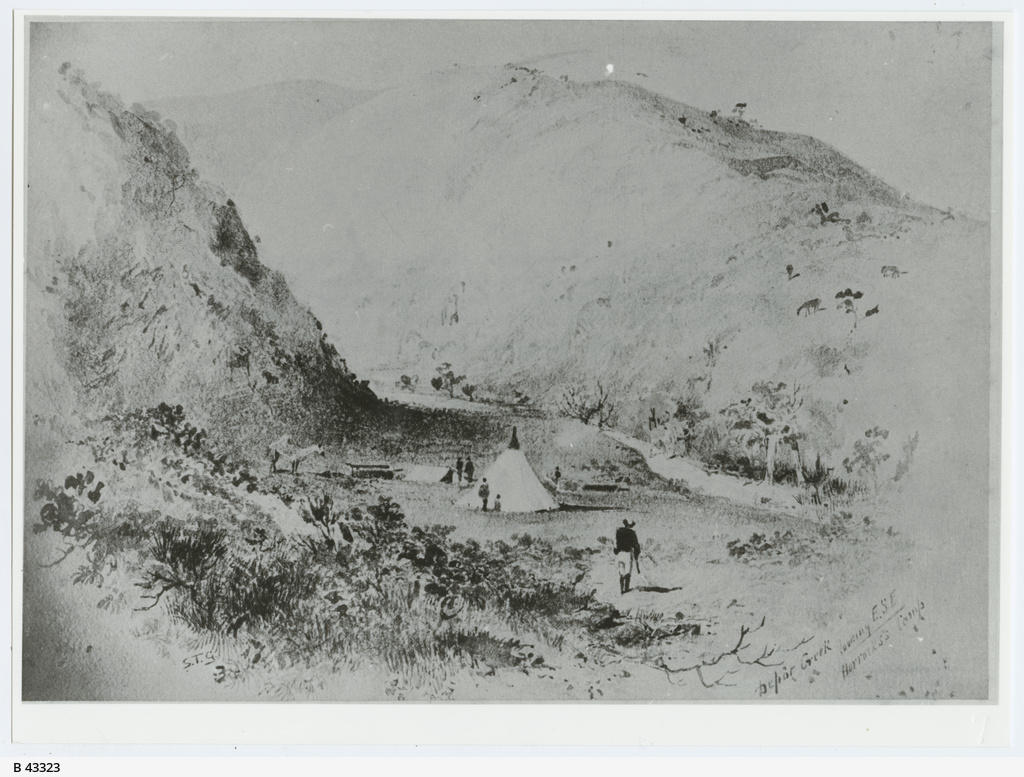 Depot Creek, Flinders Ranges | State Library of South Australia B 43323
Depot Creek, Flinders Ranges | State Library of South Australia B 43323
Artist: Gill, S.T. | Date: 1846-08/1847-01~ | Appleyard cat. n/a
Catalogue: S.T. Gill's Horrocks Expedition Pictures 1846-1847
February 1847 exhibition no. 103 "Camping Ground, Depot Creek".
This is the only view of the Depot Creek camp from this side, the other several views being from the hill behind and looking down onto the camp.
This SLSA photo was thought to be of an AGSA picture, but there is no corresponding catalogued work.
Map | S. T. Gill - Works Mapped
456
Waterplace, Depot Creek, Augst. 27th | National Library of Australia R352
Artist: Gill, S.T. | Date: 1846-08/1847-01~ | Appleyard cat. n/a | 19(H) x 31.3(W) cm
Catalogue: S.T. Gill's Horrocks Expedition Pictures 1846-1847
February 1847 exhibition no. 104 "Lower Water-hole, Depot Creek".
The scene shows the expedition's water source at Depot Creek. Getting water for the horses from a hole is the party (left to right): Theakston, a European man drawing water from a hole in the creek bed (probably one of the "men" - Kilroy or Garlick) and Horrocks (seated on a keg). In the foreground Aboriginal man Jimmy Moorhouse leads Harry the camel with a keg of water.
Reverse inscription: "Waterplace, Depot Creek, Augst. 27th" by Gill. The original camp was moved higher up the creek on 24 August. On 27 August the party was making final preparations to leave Depot Creek the next morning and explore to the northwest.
Catalogue Group: NLA R347 to R354 are from the Horrocks 33, based on subject matter and Sturt provenance.
Map | S. T. Gill and Horrocks expedition 1846
305
 Sketch from summit of Flinders Range | Art Gallery of South Australia 997P37
Sketch from summit of Flinders Range | Art Gallery of South Australia 997P37
Artist: Gill, S.T. | Date: 1846-08~/1847-01~ | Appleyard cat. n/a | 18.1(H) x 29.7(W) cm
Catalogue: S.T. Gill's Horrocks Expedition Pictures 1846-1847
February 1847 exhibition possibly no. 105 "Sketch from summit Flinder's [sic] Range E." or no. 106. "Sketch from summit Flinder's [sic] Range E.N.E." – correspondence uncertain.
A view of Flinders Range. The topography seems consistent with a view north (not east) to distant Mount Arden.
Inscribed (l.l. just visible) "F. Range(s) ...[text unclear]" of the same style as that on NLA R351. Also somewhat similar to NLA R349.
However the location is uncertain.
Catalogue Group: AGSA's catalogue gives the dimensions as "18.1 x 19.7 (sight)" but this seems to be a typographical error and the width could be 29.7 making it the same size as the Horrocks pictures of Sturt provenance (NLA).
Map | S. T. Gill and Horrocks expedition 1846
553
Grassy hills at the head of Spencer Gulf | National Library of Australia R349
Artist: Gill, S.T. | Date: 1846-08/1847-01~ | Appleyard cat. n/a | 19(H) x 31.1(W) cm
Catalogue: S.T. Gill's Horrocks Expedition Pictures 1846-1847
February 1847 exhibition possibly no. 105 "Sketch from summit Flinder's [sic] Range E." or no. 106. "Sketch from summit Flinder's [sic] Range E.N.E." – correspondence uncertain.
There are hills in the foreground, middle ground and background. The light blue before the background ranges appears to be flat land, not water.
The location is unknown. The image is somewhat similar in topography to AGSA 997P37 which seems to be near Depot Creek and Mount White. However this seems a more southerly location.
No reverse inscription. There may be pencilled artist notes l.l. but they are not decipherable.
Catalogue Group: NLA NLA R347 to R354 are from the Horrocks 33, based on subject matter and Sturt provenance.
Map | S. T. Gill and Horrocks expedition 1846
434
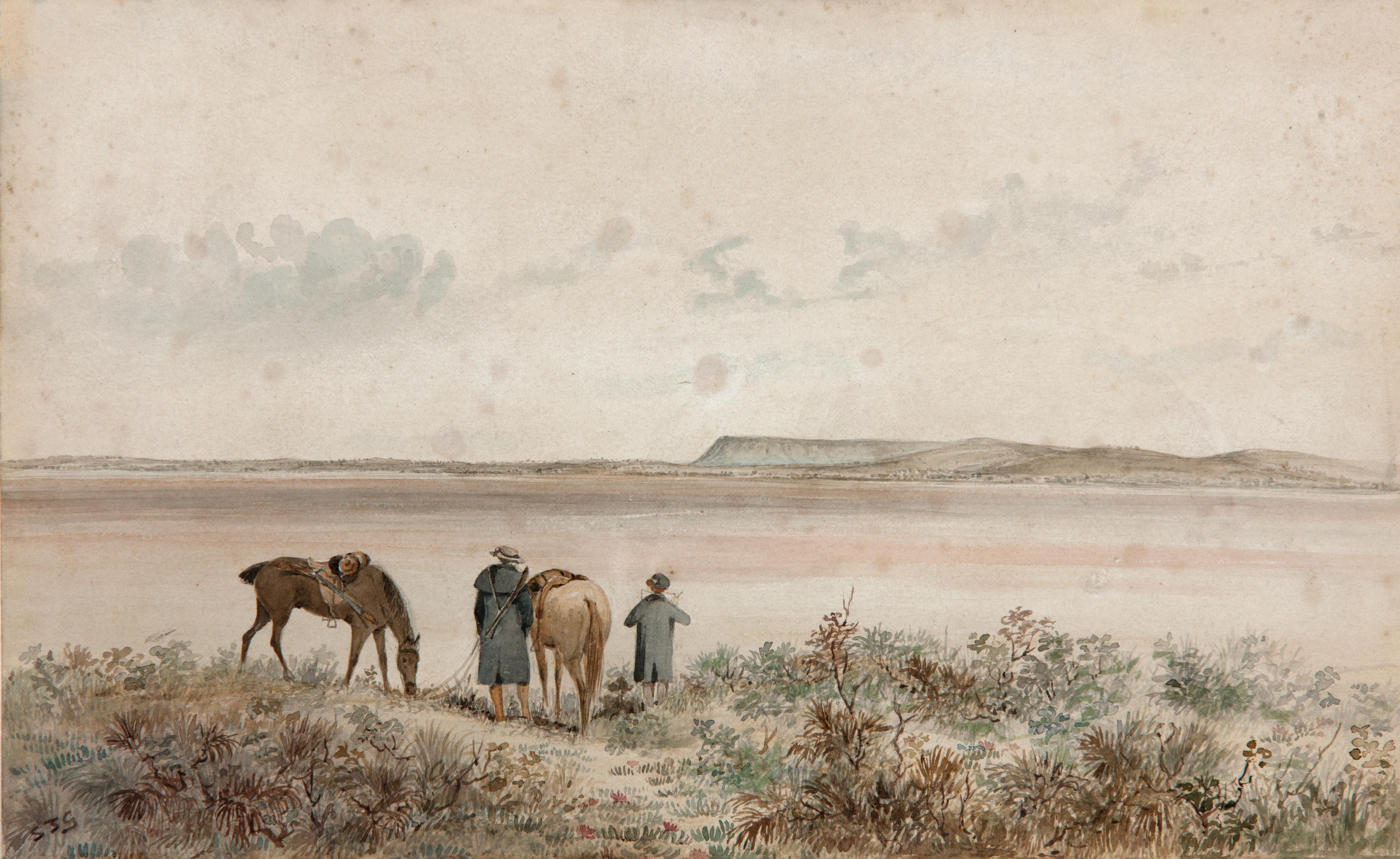 View of Lake Torrens, August 22nd | Art Gallery of South Australia 997P40
View of Lake Torrens, August 22nd | Art Gallery of South Australia 997P40
Artist: Gill, S.T. | Date: 1846-08/1847-01~ | Appleyard cat. n/a | 18.2(H) x 32(W) cm
Catalogue: S.T. Gill's Horrocks Expedition Pictures 1846-1847
February 1847 exhibition no. 107 "Neck of Lake Torrens, looking N.W.".
View west from near Depot Creek. On 22 August, Horrocks and Gill are about to set off from Depot Creek for a two day return trip west (to Uro Bluff, horizon, centre). Before them lies a salty flat between Spencer Gulf and Lake Torrens and what they thought was a raised island between two creeks where they camped that night.
Gill's student, W.A. Cawthorne, did his own contemporary version of this scene from Gill's original. This appears to be another case where Gill subsequently refined his original image into this final watercolour in the series of 33.
Catalogue Group: The same dimensions as the Horrocks pictures of Sturt provenance (NLA).
Map | S. T. Gill and Horrocks expedition 1846
336
Crossing the Neck of the Lake Torrens | State Library of New South Wales PX*D 30 f.04
Artist: Cawthorne, W.A. | Date: 1846-12/1847
Main listing: S.T. Gill's Horrocks Expedition Pictures 1846-1847
Cawthorne painted this probably from Gill's original Horrocks expedition sketch for "View of Lake Torrens, August 22nd" (AGSA 997P40). This version shows Gill ahead in the middle ground and emphasises the island where the pair camped that night. Point Encounter (Uro Bluff) is on the horizon, centre.
The watercolour shows Cawthorne's artist notes (e.g. "red").
Map | S. T. Gill and Horrocks expedition 1846
455
Encounter between Horrocks and Gill and two Barnggarla men and a child near Uro Bluff, South Australia | State Library of Victoria H8213
Artist: Gill, S.T. | Date: 1846-08/1847-01~ | Appleyard cat. 92 | 18.2(H) x 22.7(W) cm
Catalogue: S.T. Gill's Horrocks Expedition Pictures 1846-1847
February 1847 exhibition no. 108 "Interview with Blacks near Table-land".
Horrocks and Gill speak with two Aboriginal men and a child or youth, who have left their spears and bags on the ground. The youth seems nervously fascinated by their horses. Point Encounter (Uro Bluff) is in the background. Horrocks holds a pannikin.
"... two men and another child who stood some time and then boldly advanced, threw down their wallets, and came up with their spears: on which we motioned them to sit down, which they did, spoke to them, and made signs for water... Mr H. gave them each a small piece of tobacco, which they appeared to eat; he shewed them how he lit his pipe with the burning-glass; they all the time appeared ill-pleased with us, the old man more particularly; the young one had bound round his head a piece of a red nightcap, unsoiled and unfaded, and knew a knife by name." (Gill, 22 August 1846)
"Mr. Gill leading my horse, I advanced and made signs of peace, when two men and a young boy, armed with several jagged spears, came to meet me. They sent away the women and children, and were very sulky. For a long time they would not show us water, which eventually was within fifty yards, the remains of rain. They appeared alarmed at the horses. After we had all drank they departed, the old man gesticulating and threatening us. I fired off a gun to see if it would intimidate them but to no purpose, the old man appearing to wish the other two to attack us. He stopped until we went round the side of the hill, when I left Mr. Gill and ascended to the top." (Horrocks, 22 August 1846)
A painting of this scene was described as one of a series of 33 paintings in the "South Australian" on 5 January 1847: "There is also a very graphic representation of a fight with the blacks, and of a previous interview with a sable pair, whose expression of countenance is absolutely satanic."
Catalogue Group: This is the same height as the Horrocks pictures of Sturt provenance (NLA).
Map | S. T. Gill and Horrocks expedition 1846
287
 Looking SW from Table Land, August 22nd | Art Gallery of South Australia 997P39
Looking SW from Table Land, August 22nd | Art Gallery of South Australia 997P39
Artist: Gill, S.T. | Date: 1846-08/1847-01~ | Appleyard cat. n/a | 18.1(H) x 30.7(W) cm
Catalogue: S.T. Gill's Horrocks Expedition Pictures 1846-1847
February 1847 exhibition no. 109 "Country looking S.W. near Table-land".
Horrocks and Gill left their horses at the base of Point Encounter (Uro Bluff). Gill says they both ascended the hill; Horrocks says he alone went up (presumably while Gill minded the horses).
"We watered the horses and drank ourselves, mounted, and went on to the south end of the table land; went two miles and tied up the horses. Mr H. and I climbed the hill, which was excessively stoney and steep ..." (Gill, 22 August 1846)
I discuss this discrepancy above in Gill Refines His Images.
Catalogue Group: The same dimensions as the Horrocks pictures of Sturt provenance (NLA).
Map | S. T. Gill and Horrocks expedition 1846
302
Country NW of tableland, Aug. 22 | National Library of Australia R347
Artist: Gill, S.T. | Date: 1846-08/1847-01~ | Appleyard cat. n/a | 19(H) x 30.7(W) cm
Catalogue: S.T. Gill's Horrocks Expedition Pictures 1846-1847
February 1847 exhibition no. 110 "Sketch from summit of Table-land, N.W.".
View from the top of Point Encounter (Uro Bluff) with (left to right) Horrocks (with gun) and Gill. They appear to be examining Gill's large format sketch book and Gill's portfolio is at his feet. The horses are at the base of the hill.
Gill says they both ascended the hill; Horrocks says he alone went up (presumably while Gill minded the horses). (Gill seems to represent the hill higher than it actually is.)
"Mr H. and I climbed the hill, which was excessively stoney and steep, taking with us the spy-glass to look over the north-west country, which presented a most desolate aspect – one immense space of dry sandy country, covered with a low, dry, crisp scrub, without the slightest vestige of grass or probability of water. I took a sketch of this un-cheering scene, which shows the distant bit of elevated land." (Gill, 22 August 1846)
Horrocks wrote that he alone ascended the hill: "... we went round the side of the hill, when I left Mr. Gill and ascended to the top. About sixty or seventy miles north-west were two rises, a table and the other a small round hill about two miles in length. All the space between and on both sides for many miles a large plain covered with stunted trees and scrub, with innumerable sand rises. The view I had convinced me that it was impossible to expect to find any country in that direction, and, moreover, too late in the season to traverse it. I descended the hill, which is very steep and rocky, and made up my mind to return to the camp and follow up the table land hills with the camel." (Horrocks, 22 August 1846)
I discuss this discrepancy above in Gill Refines His Images.
Signed "STG" lower centre right.
Catalogue Group: NLA R347 to R354 are from the Horrocks 33, based on subject matter and Sturt provenance.
Map | S. T. Gill and Horrocks expedition 1846
308
 Attack of Natives, sunset (Fight with the Blacks) | Work untraced
Attack of Natives, sunset (Fight with the Blacks) | Work untraced
Artist: Gill, S.T. | Date: 1846-08/1847-01~ | Appleyard cat. n/a
Catalogue: S.T. Gill's Horrocks Expedition Pictures 1846-1847
February 1847 exhibition no. 111 "Attack of Natives, sunset".
Horrocks and Gill clashed with Aboriginal people shortly after turning from Point Encounter (Uro Bluff).
"On observing them running down towards us with their spears, we halted and fired three balls, which struck the ground very near them, in each case rising the dust in a cloud; this brought them to a stand for a little, but they did not appear to know the use of the arms, as they looked on the ground and moved but little aside. We reloaded and advanced towards them, when they took up their position on the top of the hill, shouting and laughing defiance. We stopped at eighty yards, and gave them three barrels more, when we saw no more of them..." (Gill, 22 August)
Described in the "South Australian" newspaper on 5 January 1847: "a very graphic representation of a fight with the blacks".
The original of this painting is unknown. However there is a contemporary pencil sketch of this scene by Gill or his student W.A. Cawthorne (SLNSW PXD 30 f26b),
428
 Attack of the Natives | State Library of New South Wales PX*D 30 f.26b
Attack of the Natives | State Library of New South Wales PX*D 30 f.26b
Artist: Gill or Cawthorne | Date: 1846-12/1847
Main listing: S.T. Gill's Horrocks Expedition Pictures 1846-1847
This is a partial sketch in pencil of Gill's "Attack of Natives, sunset" of 22 August 1846 on the Horrocks expedition. It is on the back of f.26a "View of the N.W. from Flinders Range". It could be by Gill for his student WA Cawthorne or it could be Cawthorne's copy of Gill's original expedition sketch.
470
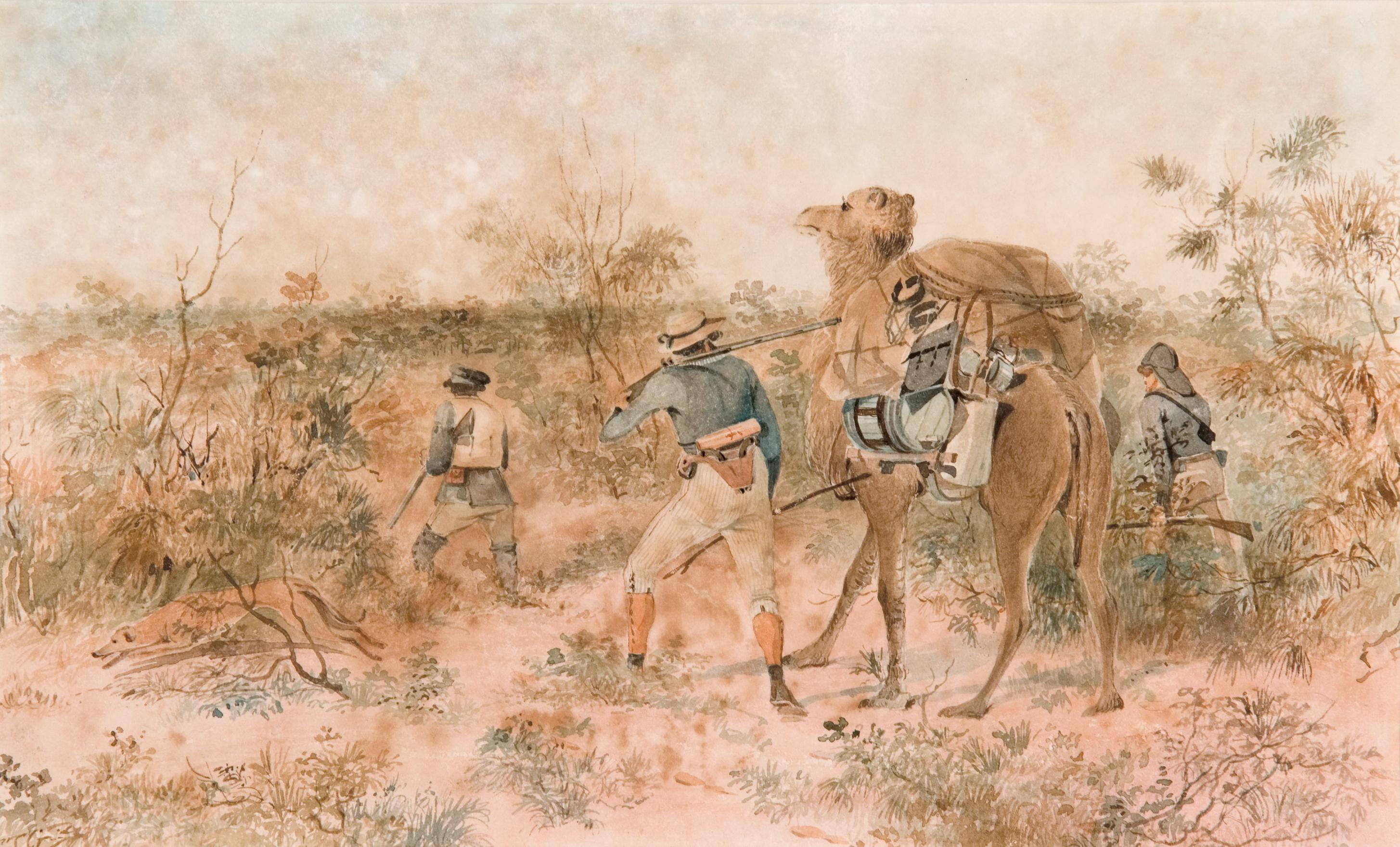 Travelling through the brush and sandridges, August 30 | Art Gallery of South Australia 0.1126
Travelling through the brush and sandridges, August 30 | Art Gallery of South Australia 0.1126
Artist: Gill, S.T. | Date: 1846-08/1847-01~ | Appleyard cat. 96 | 18.6(H) x 30.2(W) cm
Catalogue: S.T. Gill's Horrocks Expedition Pictures 1846-1847
February 1847 exhibition no. 112 "Party travelling en route to N.W. country".
The expeditioners head northwest on foot (left to right): Gill, Horrocks, Harry the camel, Kilroy.
"Left the hills and crossed in our course many red sandy and thickly scrub'd ridges. As yet we have met with no feed or indications of improvement. We saw some fresh tracks of natives crossing our course, but they were few... sixteen-miles tramp." (Gill, 30 August)
Catalogue Group: The same dimensions as the Horrocks pictures of Sturt provenance (NLA). Davenport provenance.
Map | S. T. Gill and Horrocks expedition 1846
291
Camp in desert, Sept. 1st | National Library of Australia R350
Artist: Gill, S.T. | Date: 1846-08/1847-01~ | Appleyard cat. 97 | 19(H) x 30.6(W) cm
Catalogue: S.T. Gill's Horrocks Expedition Pictures 1846-1847
February 1847 exhibition no. 113 "Camp in the scrub, evening".
The party camp in the scrub on the evening of 30 August (left to right): Gill, Kilroy, Horrocks' dog, Harry the camel, and Horrocks taking a sight from up a tree. Horrocks is likely planning the next day's northwest travel and looking out for activity of Aboriginal people. "Having to camp in scrub, set watch through the night." (Gill, 30 August)
This painting appears to have been incorrectly titled and dated prior to its accession into the National Library. The scene is less desert and more scrub and corresponds with the 1847 exhibit and Gill's diary.
[Appleyard reliably notes that, based on Gill's diary description, this is most likely the camp on the night of 30 or 31 August. The diary description would tend to favour the 30th. The chronological sequence of the exhibition also supports this being the night of 30 August.]
Catalogue Group: NLA R347 to R354 are from the Horrocks 33, based on subject matter and Sturt provenance.
Map | S. T. Gill and Horrocks expedition 1846
292
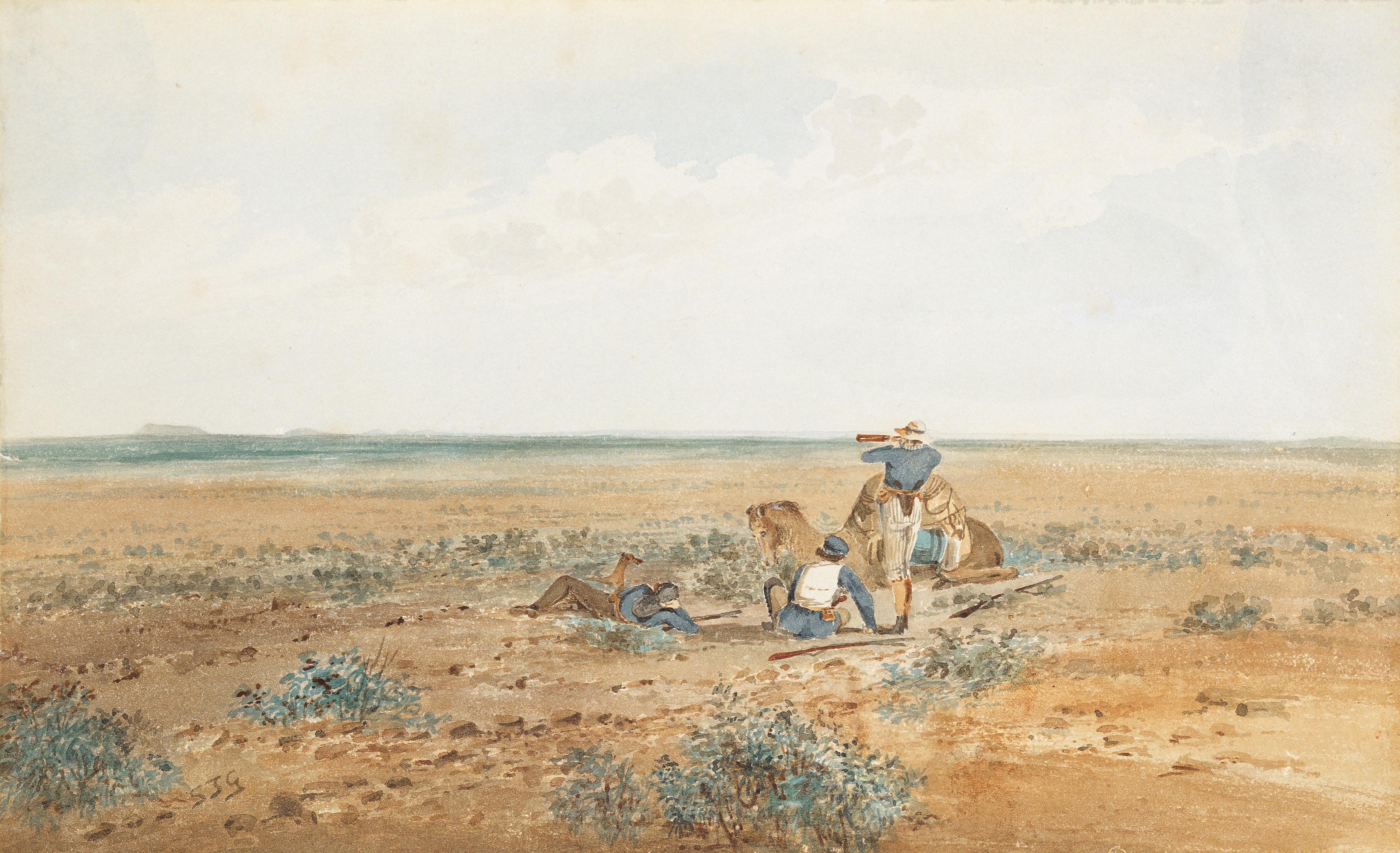 Halt on Stoney [sic] ... August 31st | Art Gallery of South Australia 997P38
Halt on Stoney [sic] ... August 31st | Art Gallery of South Australia 997P38
Artist: Gill, S.T. | Date: 1846-08/1847-01~ | Appleyard cat. n/a | 43.2(H) x 58.3(W) cm
Catalogue: S.T. Gill's Horrocks Expedition Pictures 1846-1847
February 1847 exhibition no. 114 "Rising land as seen from Sterile Plain".
The expeditioners head northwest on foot (left to right): Horrocks' dog, Kilroy, Harry the camel, Gill, and Horrocks taking a sight.
"Marched on, and at length broke on a sterile stony plain, from which we could distinctly see the rising land we were making for, towering out of dense scrub, which would occur three miles further on. Halted for one hour, to rest and feed the camel, which we did by walking over the plains and collecting salsolaceous plants of such kinds as we had observed him eat before. Went on, and halted about six o'clock." (Gill, 31 August)
On the reverse is a preliminary pencil outline of Horrocks and Gill for "Return of invalid" AGSA 0.1127.
Catalogue Group: In AGSA 997P34 to 997P40 the majority of which are the same dimensions as the Horrocks pictures of Sturt provenance (NLA).
Map | S. T. Gill and Horrocks expedition 1846
303
S.L. [i.e. salt lake] looking SW Sept. 1st | National Library of Australia R353
Artist: Gill, S.T. | Date: 1846-09/1847-01~ | Appleyard cat. n/a | 19(H) x 31(W) cm
Catalogue: S.T. Gill's Horrocks Expedition Pictures 1846-1847
February 1847 exhibition no. 115 "Salt Lake, looking N.".
A view of the salt lake, looking southwest.
"... continued walking up to twelve o'clock, when we came on a large lake, with a little water in it, the drainage of the country round. Stopped to test the quality of the water, but found it very salt. I sketched the lake ..." (Gill, 1 September)
The salt lake was named Lake Gill Lake by Horrocks (Horrocks' letter to C. Platts from Depot Creek, 8 September 8), but subsequently named Lake Dutton.
Catalogue Group: NLA R347 to R354 are from the Horrocks 33, based on subject matter and Sturt provenance.
Map | S. T. Gill and Horrocks expedition 1846
306
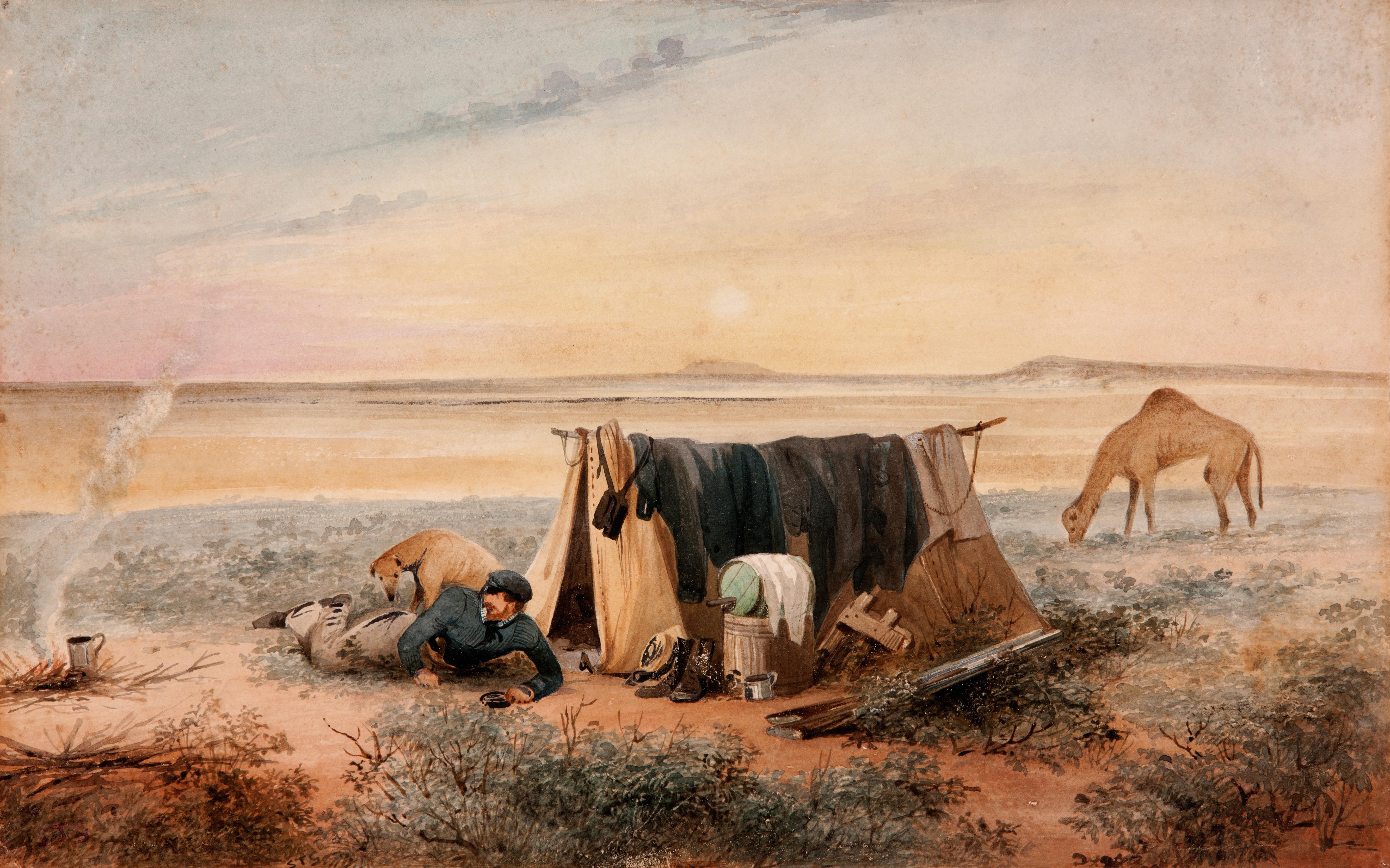 Invalid's tent, salt lake 75 miles north-west of Mount Arden | Art Gallery of South Australia 0.1253
Invalid's tent, salt lake 75 miles north-west of Mount Arden | Art Gallery of South Australia 0.1253
Artist: Gill, S.T. | Date: 1846-09/1847-01~ | Appleyard cat. 98 | 21.4(H) x 34.2(W) cm
Catalogue: S.T. Gill's Horrocks Expedition Pictures 1846-1847
February 1847 exhibition no. 117 "Invalid's tent, furthest point attained".
Gill reclining outside the tent in which Horrocks rests after his accident. Harry the camel and the salt lake (Lake Gill now Lake Dutton) are in the background. Gill nursed Horrocks and his injuries while awaiting the return of help.
This scene was described as one of a series of 33 paintings in the "South Australian" on 5 January 1847: "Some of these pictures are possessed of a peculiar interest, as, for instance, one representing the extreme point attained by the party. In the foreground appears the invalid's tent, with Mr Gill watching outside – the country in the background presenting a most inhospitable and desolate appearance."
Catalogue Group: Horrocks family provenance: acquired from Arthur Horrocks 1944. Title on mount: Horrocks wounded - S T Gill awaiting help outside Horrocks's tent, 1 September 1846. (Appleyard).
Map | S. T. Gill and Horrocks expedition 1846
293
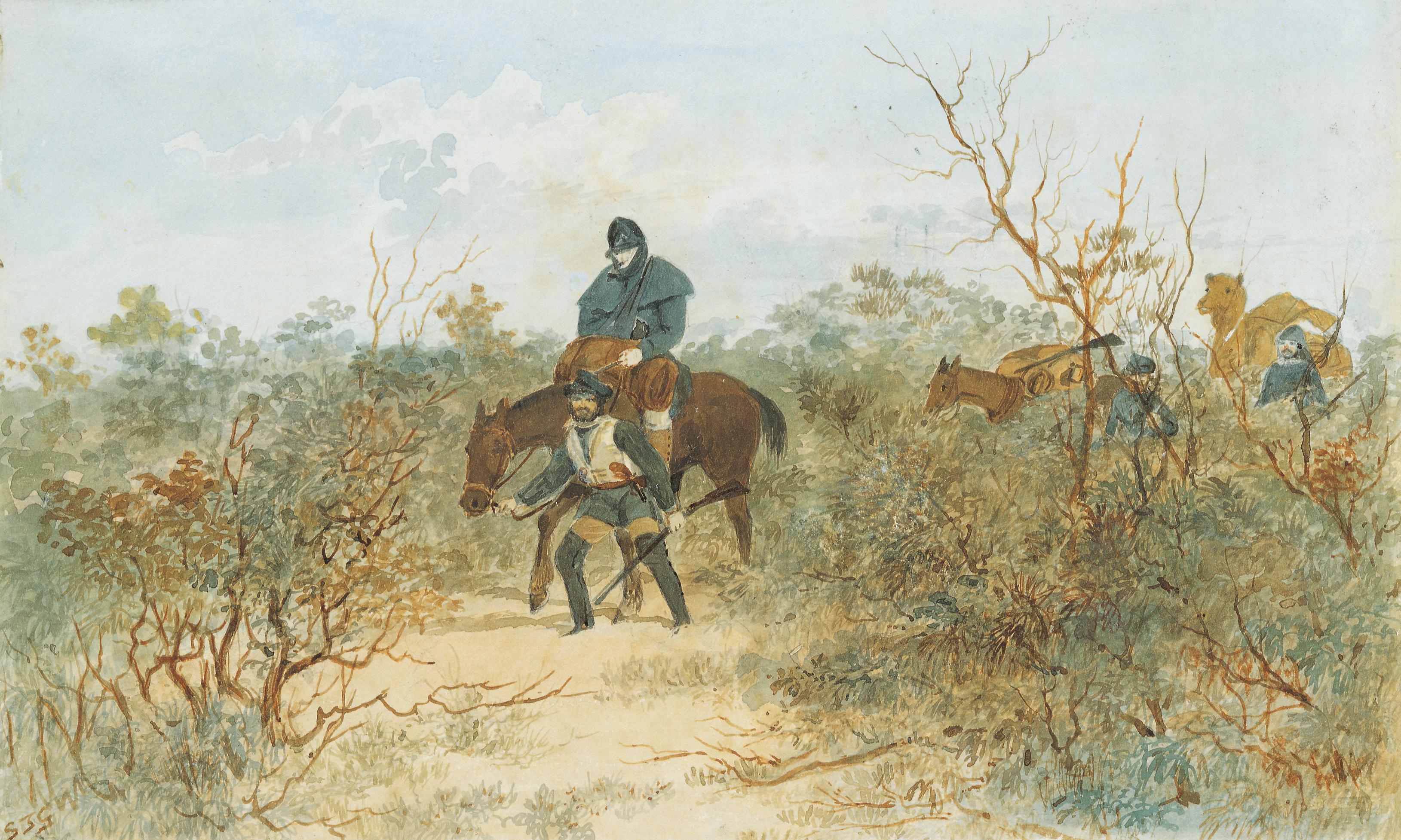 Return of invalid | Art Gallery of South Australia 0.1127
Return of invalid | Art Gallery of South Australia 0.1127
Artist: Gill, S.T. | Date: 1846-09/1847-01~ | Appleyard cat. 99 | 18.4(H) x 30.3(W) cm
Catalogue: S.T. Gill's Horrocks Expedition Pictures 1846-1847
February 1847 exhibition no. 118 "Invalid's return to depot".
The party returning to Depot Creek after Horrocks' accident. Left to right: Gill leading the horse with Horrocks, Theakston (with a red beard), Kilroy (with legionnaires hat). This is the only expedition picture showing Kilroy's face.
This scene was described as one of a series of 33 paintings in the "South Australian" on 5 January 1847: "Another [picture] represents Mr Horrocks returning, after having sustained that distressing accident which hurried him to a premature grave."
A pencil outline of Horrocks and Gill for this picture is on the back of "Halt on stoney plain, August 31st" (AGSA 997P38).
Catalogue Group: The same dimensions as the Horrocks pictures of Sturt provenance (NLA). Davenport provenance.
Map | S. T. Gill and Horrocks expedition 1846
294
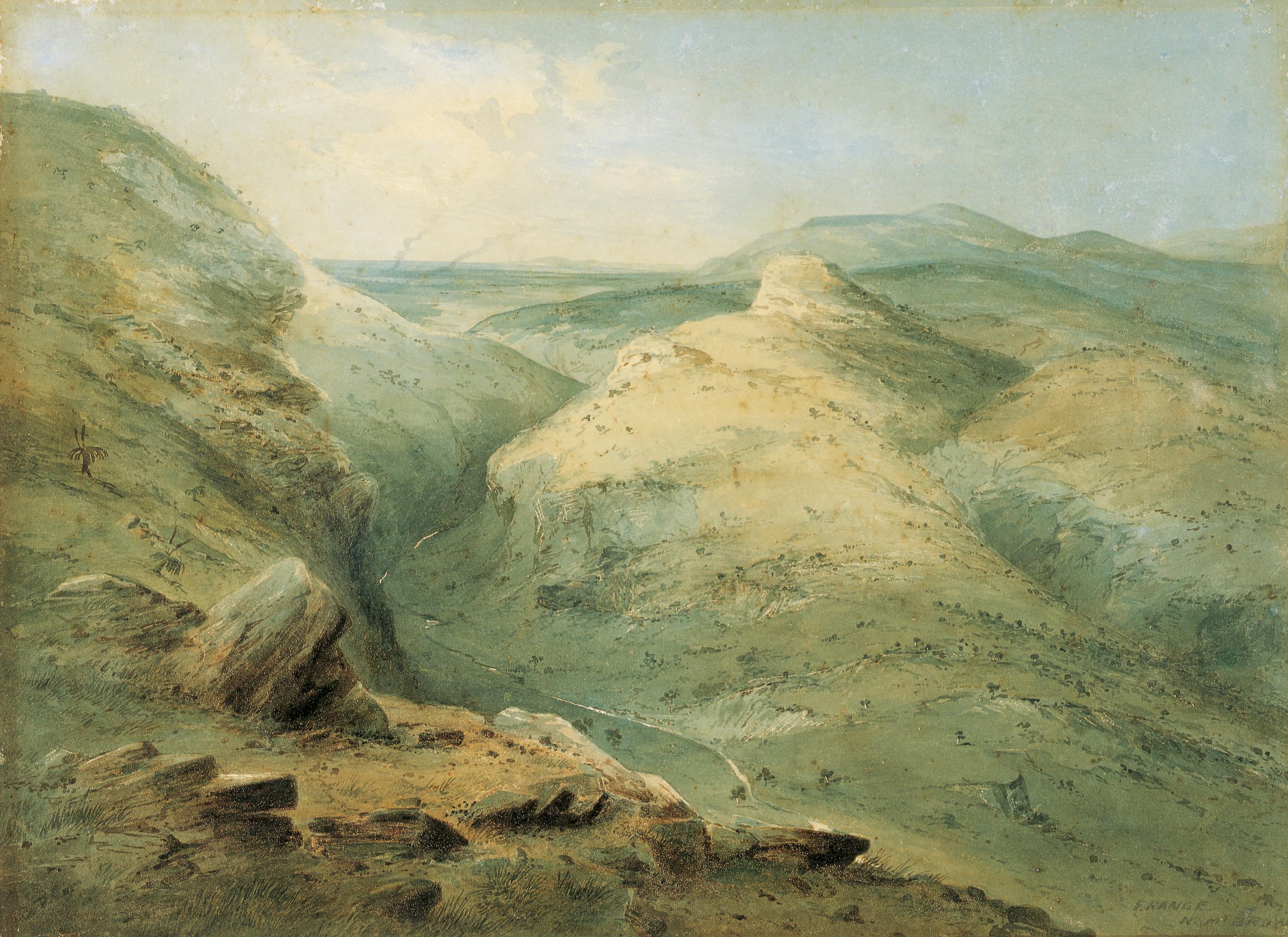 Flinders Range, north of Mount Brown | Art Gallery of South Australia 8111HP88
Flinders Range, north of Mount Brown | Art Gallery of South Australia 8111HP88
Artist: Gill, S.T. | Date: 1846-08/1850~ | Appleyard cat. 101 | 34(H) x 46.2(W) cm
Catalogue: S.T. Gill's Horrocks Expedition Pictures 1846-1847
February 1847 exhibition no. 119 "Large Creek N. of Mt. Brown".
Through this mountain pass lies a plain and a rising land on the horizon. Smoke is seen from the fires of Aboriginal people.
This could be Horrocks Pass with Spencer Gulf in the background suggesting the view point may be on the eastern side of Flinders Range and showing a view north to Mount Brown..
The caption (l.r.) in watercolour is "F. RANGE / N Mt BROWN".
"Left the creek about half-past nine, and reached the large creek, 5 miles north of Mount Brown ; walked about 19 miles, camped the night. The weather was very showery through the day." (Gill, 10 September) Although this description might match, on this day the expedition was focussed on taking Horrocks back for medical attention and Gill doesn't report sketching. Horrocks left the group the next morning.
This scene is unusual in that there are no people or animals, a characteristic which seems to be associated wih the return journey after Horrocks' accident.
Location uncertain.
Catalogue Group: Uncertain as whether one of 33 but has a similar title to exhibition.
Map | S. T. Gill and Horrocks expedition 1846
296
![Thumbnail image for Spencer's Gulf from Camp ... S of Mt. B[rown] | AGSA 997P36](https://agsa-prod.s3.amazonaws.com/media/dd/images/61135-HQ-997P36_Cropped.b69943b.jpg) Spencer's Gulf from Camp ... S of Mt. B[rown] | Art Gallery of South Australia 997P36
Spencer's Gulf from Camp ... S of Mt. B[rown] | Art Gallery of South Australia 997P36
Artist: Gill, S.T. | Date: 1846-08/1847-01~ | Appleyard cat. n/a | 19(H) x 31.8(W) cm
Catalogue: S.T. Gill's Horrocks Expedition Pictures 1846-1847
February 1847 exhibition no. 120 "Spencer's Gulf from Camp S. of Mt. Brown".
The expeditioners' camp with Spencer's Gulf in the background. Four men are around the campfire. In the scene are a tent, two drays and some goats, but no camel or horses. The man reclining by the fire with the red beard may be Gill. The men are likely (left to right): Gill (or possibly Kilroy), Horrocks, Moorhouse and Theakston.
The scene corresponds best with the description of the camp on the night of 20th August. (On that night the horses had wandered off – they're absent from this picture.) However the water in the background would be consistent with the camp on the 19th, not the 20th. The party was south of Mount Brown on 19 August 1846 where it camped after crossing the range.
There are pencilled artist notes visible in this picture including "pale gum scrub", an "X" on the far shore and Horrocks' outline.
Catalogue Group: The same dimensions as the Horrocks pictures of Sturt provenance (NLA).
Map | S. T. Gill and Horrocks expedition 1846
299
 Funeral of Mr. Horrocks | Work untraced
Funeral of Mr. Horrocks | Work untraced
Artist: Gill, S.T. | Date: 1846-09-24/1847-01~ | Appleyard cat. n/a
Catalogue: S.T. Gill's Horrocks Expedition Pictures 1846-1847
February 1847 exhibition no. 122 "Funeral of Mr. Horrocks". This painting was also noted as one of a series of 33 paintings in the "South Australian" on 5 January 1847: 6. <http://nla.gov.au/nla.news-article71606913>.
John Ainsworth Horrocks died as a result of his wounds on 23 September 1846 at Penwortham. His funeral was held the following day.
It is possible this painting remained with the Horrocks family in England and has been lost. (See also Appleyard 119 n.27.)
Map | S. T. Gill and Horrocks expedition 1846
427
At the February 1847 exhibition Gill showed the Horrocks 33 plus five other Horrocks related works. They are listed below along with the exhibition catalogue number, catalogue description, date of the scene, reference to the source diary (Gill and/or Horrocks) and a link to details of the work (which are further down this page). Dates are in yyyy-mm-dd format. Ordered by exhibit number.
As well as the 33, there are other Horrocks related works in the February 1847 exhibition.
David Coombe, February 2022. Updated 18 July 2025. Formatted 19 October 2025. | text copyright (except where indicated)
CITE THIS: David Coombe, 2022-2025, S.T. Gill's Horrocks Expedition Pictures 1846-1847, accessed dd mmm yyyy, <https://coombe.id.au/S_T_Gill/S_T_Gill's_Horrocks_Expedition_Pictures_1846_1847.htm>